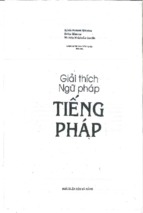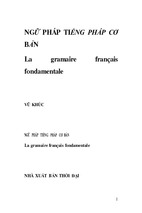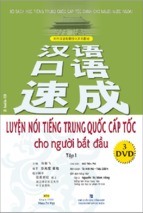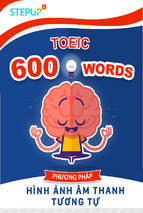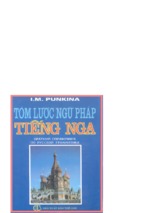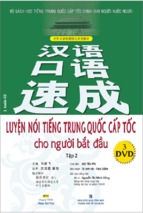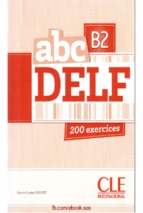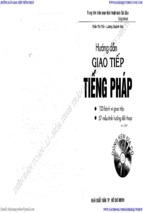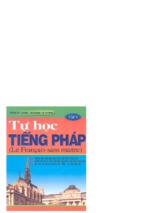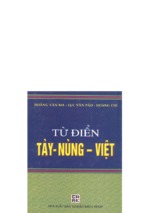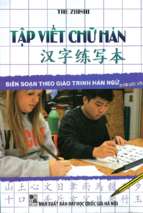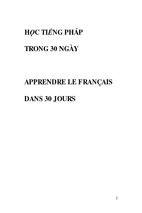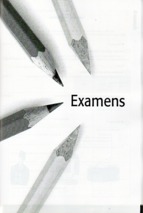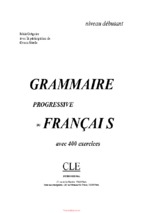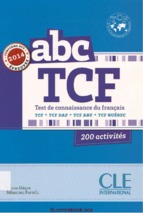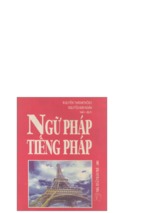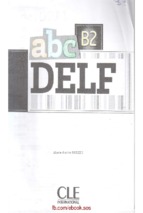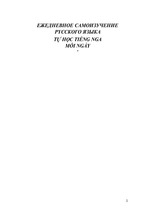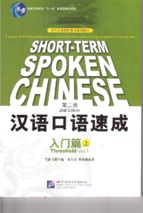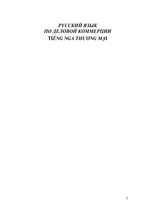Tiếng Trung cơ bản cho người mới bắt đầu. Nội dung bao gồm những câu giao tiếp đơn giản, dễ học cho các bạn mới làm quen...
1.01 Example sentences with temporary states
我很忙。
Wǒ hěn máng.
李雪很饿。
Lǐ Xuě hěn è.
孩子们很困。
Háizǐmen hěn kùn.
他很兴奋。
Tā hěn xīngfèn.
I'm very busy.
Li Xue is very hungry.
The children are very sleepy.
He is very excited.
我同屋很累。
My roommate is very tired.
Wǒ tóngwū hěn lèi.
>> Listen to the MP3 (right click to save)
21.02 Adjectives describing appearance
高
矮
瘦
胖
Gāo
Tall
Ǎi
Short
Shòu
Thin
Pàng
Fat
漂亮
丑
帅
强壮
Qiángzhuàng Chǒu
Piàoliɑng Shuài
Handsome Strong
Ugly
Pretty
大
小
Dà
Xiǎo
Big
Small
>> Listen to the MP3 (right click to save)
21.03 Physical characteristics - Example sentences
你学校很大。
Nǐ xuéxiào hěn dà.
她哥哥很高。
Tā gēge hěn gāo.
他妈妈很矮。
Tā māma hěn ǎi.
你弟弟很瘦。
Nǐ dìdi hěn shòu.
我妹妹很漂亮。
Your school is very big.
Her older brother is very tall.
His mother is very short.
Your little brother is very thin.
My little sister is very pretty.
Wǒ mèimei hěn piàoliɑng.
她男朋友很帅。
Her boyfriend is very handsome.
Tā nánpéngyou hěn shuài.
>> Listen to the MP3 (right click to save)
21.04 Family description
我妈妈很矮,很瘦。我爸爸很胖,很强壮。我也有一个姐姐。她很漂亮。
Wǒ māma hěn ǎi,hěn shòu. Wǒ bàbɑ hěn pàng, hěn qiángzhuàng. Wǒ yě yǒu yígè mèimei. Tā
hěn piàoliɑng.
21.05 Negation of predicate adjectives
他不帅。
Tā bú shuài.
李雪不高。
Lǐ Xuě bù gāo.
她不瘦。
Tā bú shòu.
王军不胖。
Wáng Jūn bú pàng.
He isn't handsome.
Li Xue is not tall.
She isn't thin.
Wang Jun is not fat.
张老师不矮。
Teacher Zhang is not short.
Zhāng lǎoshī bù ǎi.
Notes:
Predicate adjectives are always negated with 不 bú, which always precedes the predicate
adjective. You can not use 没 méi to negate a predicate adjective.
21.06 Hair description vocabulary
短
头发 长
Tóufa Cháng Duǎn
Hair Long Short
卷
直
Juǎn Zhí
Curly Straight
>> Listen to the MP3 (right click to save)
21.07 His hair is very short. - Example sentences
他的头发很短。
Tā de tóufa hěn duǎn.
His hair is very short.
他女友的头发很长。
Tā nǚyǒu de tóufa hěn cháng.
萨拉的头发很卷。
Sàlā de tóufa hěn juǎn.
His girlfriend's hair is very long.
Sarah's hair is very curly.
李雪的头发很直。
Li Xue's hair is very straight.
Lǐ Xuě de tóufa hěn zhí.
A Transcribe the characters below into pinyin
1.) 漂亮 _____________________ 2.) 瘦 ____________________
3.) 胖 _____________________
4.) 头发 ____________________
5.) 强壮 __________________
6.) 帅 ___________________
B Match the words with the translation
1.) Cháng
Curly
2.) Ǎi
Long
3.) Juǎn
Only son
4.) Chǒu
Short
5.) Zhí
Ugly
6.) Dúshēngzǐ
Straight
C Transcribe the following sentences into pinyin
1.) 他妹妹很漂亮。
_______________________________________________________.
2.) 我女友的头发很长。
_______________________________________________________.
3.) 你哥哥很瘦。
_______________________________________________________.
4.) 孩子们很困。
_______________________________________________________.
D Circle the character that matches the pinyin
dú : 姓
瘦
独
北 qiáng : 青
强
人
师
tóu : 国
头
瘦
直 shòu : 瘦
头
叫
京
jiě : 姐
独
北
英 dì :
名
商
头
弟
E Circle the two characters that are not the same
胖强矮师
商韩师美
韩商丑美
胖强矮高
F Translate the following pinyin into English
1.) Lǐ Xuě hěn shòu.
_______________________________________________________.
2.) Zhāng lǎoshī bù ǎi.
_______________________________________________________.
3.) Wǒ bàbɑ hěn pàng, hěn qiángzhuàng.
_______________________________________________________.
4.) Nǐ dìdi de tóufa hěn cháng.
_______________________________________________________.
G Make words by matching the two characters, then match them to the correct pinyin
介
发
piàoliɑng
职
亮
qiángzhuàng
强
员
tóufa
漂
绍
zhíyuán
头
壮
jièshào
H Circle the pinyin for the character
短 : fāng
xiōng
jiàn
帅 : xiān
fāng
shuài
直 : zhí
diǎn
shén
duǎn 漂 : jiě
piào
míng
piào 丑 : yǒu
chǒu
shuài
壮 : zhí
duǎn
fāng
chǒu
I Fill in the blanks with the most appropriate choice
点
头发 有 卷 父母
Diǎn Tóufa Yǒu Juǎn Fùmǔ
1.) 她男朋友的 __________ 很短。
běi
fāng
zhuàng
2.) 他女友的头发很 __________ 。
3.) 我有 __________ 渴。
4.) 他 __________ 是工人。
5.) 你 __________ 男朋友吗?
22.01 Printed Materials
书
Shū
Book
画报
杂志
报纸
Zázhì
Bàozhǐ
Huàbào
Magazine Newspaper Pictorial
小说
地图
课本
词典
Kèběn Cídiǎn
Xiǎoshuō Dìtú
Textbook Dictionary Novel
Map
>> Listen to the MP3 (right click to save)
22.02 This and that - Example sentences
这是书,那是词典。
Zhè shì shū, nà shì cídiǎn.
This is a book, that is a dictionary.
这是报纸,那是杂志。
Zhè shì bàozhǐ, nà shì zázhì.
This is a newspaper, that is a magazine.
这是地图,那是报纸。
Zhè shì dìtú, nà shì bàozhǐ.
This is a map, that is a newspaper.
这是课本,那是小说。
This is a textbook, that is a novel.
Zhè shì kèběn, nà shì xiǎoshuō.
这是词典, 那是课本。
This is a dictionary, that is a textbook.
Zhè shì cídiǎn, nà shì kèběn.
>> Listen to the MP3 (right click to save)
Notes:
这 zhè and 那 nà are demonstrative pronouns, which means that they point out where something
is. 这 zhè means this and 那 nà means that.
Pronunciation point:
You should be careful not to confuse 那 nà with the interrogative pronoun 哪 nǎ. 那 nà has a
fourth tone falling sound, which sounds commanding or even angry to English speakers. nǎ has
the falling and then rising third tone, which to English speakers sounds a bit like someone who is
mildly incredulous of something.
22.03 Whose textbook is this? - Example sentences
那是谁的杂志?
Whose magazine is that?
Nà shì shéi de zázhì?
这是谁的课本?
Whose textbook is this?
Zhè shì shéi de kèběn?
那是谁的报纸?
Nà shì shéi de bàozhǐ?
Whose newspaper is that?
这是谁的词典?
Whose dictionary is this?
Zhè shì shéi de cídiǎn?
这是谁的画报?
Whose pictorial is this?
Zhè shì shéi de huàbào?
>> Listen to the MP3 (right click to save)
Notes:
The structural particle 的 de is usually put between the interrogative pronoun 谁 shéi and the
noun it is an attributive of.
22.04 It's the teacher's book
萨拉:
这是什么?
Zhè shì shénme?
王军: 这是书。
Zhè shì shū.
萨拉:
这是谁的书?
Zhè shì shéi de shū?
王军: 这是老师的书。
Zhè shì lǎoshī de shū.
22.05 This is my roommate's magazine - Concept review dialogue
马特:
那是什么?
Nà shì shénme?
李雪:
那是杂志。
Nà shì zázhì.
马特:
那是谁的杂志?
Nà shì shéi de zázhì?
李雪: 那是我同屋的杂志。
Nà shì wǒ tóngwū de zázhì.
22.06 Which magazine is yours? - Example sentences
哪本杂志是你的?
Nǎ běn zázhì shì nǐ de?
哪本小说是他的?
Nǎ běn xiǎoshuō shì tā de?
哪本词典是她的?
Nǎ běn cídiǎn shì tā de?
哪本书是王军的?
Nǎ běn shū shì Wáng Jūn de?
Which magazine is yours?
Which novel is his?
Which dictionary is hers?
Which book is Wang Jun's?
哪张地图是我的?
Which map is mine?
Nǎ zhāng dìtú shì wǒ de?
22.07 Sentences with possessive pronouns
这本书是我的。
Zhè běn shū shì wǒ de.
那本课本是我同屋的。
Nà běn kèběn shì wǒ tóngwū de.
这本杂志是他的。
Zhè běn zázhì shì tā de.
那份报纸是张老师的。
Nà fèn bàozhǐ shì Zhāng Lǎoshī de.
Pronunciation point:
This book is mine.
That textbook is my roommate's.
This magazine is his.
That newspaper is Zhang teacher's.
这 Zhè and 那 nà is the pronunciation you typically find in textbooks, but sometimes they may
be pronounced as zhèi and nèi, respectively. This pronunciation is only used when the words are
specifying which is which, as in "Which book out of all of these are Anna's? - This one."
Zhèi and nèi is considered to be less standard pronunciation, so there's no reason to worry about
it too muc 去 h. If you are living in China and in a region where zhèi and nèi are being used you
will probably pick them up instinctually, the way one picks up slang. Otherwise, you can never
go wrong saying Zhè and nà.
22.08 Is this your dictionary?
李雪:
萨拉:
那本词典是不是你的?
Nà běn cídiǎn shì bú shì nǐ de?
那本词典是我的。
Nà běn cídiǎn shì wǒ de.
李雪:
这本词典是不是我的?
Zhè běn cídiǎn shì bú shì wǒ de?
这本词典是你的。
Zhè běn cídiǎn shì nǐ de.
22.09 The Horrors of Pronunciation
萨拉:
直
志
纸
Zhǐ Zhì
Zhí
Straight Paper Sign
A Transcribe the characters below into pinyin
1.) 杂志 _____________________ 2.) 课本 ____________________
3.) 画报 _____________________ 4.) 词典 ____________________
5.) 地图 __________________
6.) 小说 ___________________
B Translate the pinyin into English
1.) Qiángzhuàng __________________ 2.) Cídiǎn ______________
3.) Bàozhǐ _________________
4.) Piàoliɑng ________________
5.) Xiǎoshuō _________________
6.) Dìtú ________________
C Match the words with the translation
1.) 头发
Novel
2.) 小说
Magazine
3.) 报纸
Strong
4.) 漂亮
Hair
5.) 强壮
Pretty
6.) 杂志
Newspaper
D Transcribe the following sentences into pinyin
1.) 那本词典是不是你的?
_______________________________________________________.
2.) 这本杂志是我的。
_______________________________________________________.
3.) 哪本小说是他的?
_______________________________________________________.
4.) 哪张地图是他的?
_______________________________________________________.
5.) 这是地图,那是报纸。
_______________________________________________________.
E Circle the character that matches the pinyin
tú : 纸
瘦
独
图 diǎn : 青
典
直
师
bào : 报
纸
瘦
直 zá :
瘦
词
纸
杂
dì : 地
独
志
纸 cí :
词
商
志
弟
F Translate the following pinyin into English
1.) Zhè shì shū, nà shì cídiǎn.
_______________________________________________________.
2.) Nà běn kèběn shì wǒ tóngwū de.
_______________________________________________________.
3.) Nǎ běn zázhì shì nǐ de?
_______________________________________________________.
4.) Zhè shì shéi de shū?
_______________________________________________________.
5.) Zhè shì bàozhǐ, nà shì zázhì.
_______________________________________________________.
G Fill in the blanks
马特: Nà shì ________?
李雪: _____ shì _______ .
马特: Nà shì ______ de zázhì?
李雪: Nà _____ wǒ tóngwū de ________ .
H Arrange the words into sentences
1.) zázhì shì Zhè běn de tā .
_______________________________________________________.
2.) tóngwū shì bàozhǐ fèn wǒ Nà de .
_______________________________________________________.
3.) wǒ péngyou shū shì de Nà .
_______________________________________________________.
4.) shéi
de
Nà
shì
zázhì ?
_______________________________________________________.
I Write questions for the following answers
1.) _______________________________________________________?
这本书是他的。 Zhè běn shū shì tā de.
2.) _______________________________________________________?
那是报纸。 Nà shì bàozhǐ.
3.) _______________________________________________________?
这是我同屋的小说。 Zhè shì wǒ tóngwū de xiǎoshuō.
4.) _______________________________________________________?
这是画报。 Zhè shì huàbào.
23.01 What kind of book is this?
大卫: 这是什么?
Zhè shì shénme?
小张: 这是书。
Zhè shì shū.
大卫: 这是什么书?
Zhè shì shénme shū?
小张: 这是英语书。
Zhè shì Yīngyǔ shū.
大卫: 这是谁的书?
Zhè shì shéi de shū?
小张: 这是我的书。
Zhè shì wǒ de shū.
23.02 What kind of magazine is this?
马特:
这是什么?
Zhè shì shénme?
萨拉:
这是杂志。
Zhè shì zázhì.
这是什么杂志?
马特:
Zhè shì shénme zázhì?
这是学生杂志。
Zhè shì xuésheng zázhì.
萨拉:
这是谁的杂志?
马特:
Zhè shì shéi de zázhì?
这是李雪的杂志。
Zhè shì Lǐ Xuě de zázhì.
23.03 What's its Chinese title?
陈大同:
陈大同:
Ānnà, zhè shì shéi de shū? Shì nǐ de shū ma?
不是我的啊,是我朋友的。
安娜:
Bú shì wǒ de a, shì wǒ péngyou de.
陈大同:
这是什么书?
Zhè shì shénme shū?
哦,一本小说。
安娜:
Ò, yì běn xiǎoshuō.
陈大同:
安娜:
安娜 ,这是谁的书?是你的书吗?
真的吗?那它的中文名字是什么?
Zhēn de ma? Nà tā de Zhōngwén míngzi shì shénme?
我不知道。
Wǒ bù zhīdào.
23.04
莎拉: 这是谁的书?
Zhè shì shéi de shū?
马特:
莎拉:
我同屋的。
Wǒ tóngwū de.
那本呢?
Nà běn ne?
马特:
是我的。
Shì wǒ de.
23.05 Whose book bag is this?
李雪: 这是谁的书包?
Zhè shì shéi de shūbāo?
王军:
李雪:
我的。
Wǒ de.
那个呢?
Nà ge ne?
王军:
我室友的。
Wǒ shìyǒu de.
Notes:
The head noun can be left out if it is understood what is being referred to, this is a form of
ellipsis. It is understood in the question 那个呢? Nà ge ne? the 那个 Nà ge refers to 那个书包
Nà ge shūbāo, so there is no need to restate the noun for a second time.
Vocabulary point:
书包 shūbāo means bookbag. The word is made exactly the same as in English, by joining the
word 书 shū book to 包 bāo bag.
23.06 What kind of map is this?
萨拉:
马特:
马特,这是你的本子吗?
Mǎtè,zhè shì nǐ de běnzi ma?
是。
Shì.
萨拉:
马特:
萨拉:
这是你的地图吗?
Zhè shì nǐ de dìtú ma?
不是,这是王军的地图。
Bú shì, zhè shì Wáng Jūn de dìtú.
这是什么地图?
Zhè shì shénme dìtú?
王军: 这是上海市地图。
Zhè shì Shànghǎi shì dìtú.
Vocabulary point:
上海市 Shànghǎi shì means Shanghai City.
23.07 Review
大卫:
小张:
大卫:
小张:
你有词典吗?
Nǐ yǒu cídiǎn ma?
我没有词典。
Wǒ méi yǒu cídiǎn.
那这本词典是谁的?
Nà zhè běn cídiǎn shì shéi de?
我不知道。
Wǒ bù zhīdào.
A Match the words with the translation
1.) Cídiǎn
2.) Shuài
3.) Zázhì
4.) Kèběn
5.) Shòu
6.) Pàng
7.) Dìtú
B Match the characters with the pinyin
Magazine
Dictionary
Thin
Fat
Map
Handsome
Textbook
1.) 报纸
Shūbāo
2.) 本子
Xiǎoshuō
3.) 同屋
Dìtú
4.) 书包
Bàozhǐ
5.) 地图
Běnzi
6.) 小说
Tóngwū
C Transcribe the following sentences into pinyin
1.) 这是什么地图?
_______________________________________________________.
2.) 那这本词典是谁的?
_______________________________________________________.
3.) 这是什么杂志?
_______________________________________________________.
4.) 这是你的本子吗?
_______________________________________________________.
D Translate the following pinyin into English
1.) Zhè shì shénme shū?
_______________________________________________________.
2.) Wǒ méi yǒu cídiǎn.
_______________________________________________________.
3.) Zhè shì Shànghǎi shì dìtú.
_______________________________________________________.
4.) Zhè shì shéi de zázhì?
_______________________________________________________.
E Circle the pinyin for the character
地 : pàng
dì
包 : zhè
bāo
词 : dì
yǒu
zhī
diǎn 画 : huà
zhǐ 本 : cí
běn
shū
cí
xiǎo
wū
友 : bāo
shén
běn
yǒu
tóng
tú
huà
F Fill in the blanks with the appropriate word
大卫: Nǐ yǒu __________ ma?
小张: _______ méi _________ cídiǎn.
大卫: Nà _______ běn cídiǎn shì _________ de?
小张: Wǒ bù _________ .
G Fill in the blanks with the appropriate word
萨拉: Mǎtè,zhè _____ nǐ de běnzi ma?
马特: Shì.
萨拉: Zhè shì ______ de _______ ma?
马特: Bú _______ , zhè shì Wáng Jūn _______ dìtú.
cí
萨拉: Zhè shì ________ dìtú?
王军: Zhè shì Shànghǎi shì _______.
H Circle the character that matches the pinyin
zhì : 地
图
杂
志 kè : 杂
志
课
图
shū : 图
书
叫
好 yǔ : 语
课
杂
地
dào : 课
地
图
道 shì : 美
她
室
课
24.01 Kinds of Writing Utensils
水彩笔
铅笔
钢笔 毛笔 蜡笔
Shuǐcǎibǐ
Qiānbǐ
Gāngbǐ Máobǐ Làbǐ
Pencil Watercolor Pen
Brush Crayon
brush
24.02 Whose brush is this?
马特:
这是什么?
Zhè shì shénme?
王军: 这是笔。
Zhè shì bǐ.
马特:
这是什么笔?
Zhè shì shénme bǐ?
王军: 这是毛笔。
Zhè shì máobǐ .
马特:
这是谁的毛笔?
Zhè shì shéi de máobǐ?
王军: 这是我同学的毛笔。
Zhè shì wǒ tóngxué de máobǐ .
24.03 Do you have a pen? Do you have a pencil?
安娜:
陈大同:
安娜:
陈大同:
你有钢笔吗?
Nǐ yǒu gāngbǐ ma?
我没有钢笔。
Wǒ méi yǒu gāngbǐ.
那你有铅笔吗?
Nǐ yǒu qiānbǐ ma?
我也没有铅笔。
Wǒ yě méi yǒu qiānbǐ.
24.04 Whose pen is this?
莎拉: 这支笔是谁的?
Zhè zhī bǐ shì shéi de?
李雪:
莎拉:
李雪:
是我的。
Shì wǒ de.
那支是不是你的?
Nà zhī shì bú shì nǐ de?
不是。
Bú shì.
24.05 Are you his secretary?
大卫:
他是杨经理吗?
Tā shì Yáng jīnglǐ ma?
王冬梅: 对,他是杨经理。
Duì, tā shì Yáng jīnglǐ.
大卫:
王冬梅:
你是他的秘书吗?
Nǐ shì tā de mìshū ma?
是,我是他的秘书。
Shì, wǒ shì tā de mìshū.
24.06 This is Anna from my company
王冬梅:
父亲:
王冬梅:
安娜:
父亲:
爸爸,你好!
Bàbɑ, nǐ hǎo!
噢,来,来,来,快请进,请进。
Ō, lái, lái, lái, kuài qǐng jìn, qǐng jìn.
这是我爸爸。这是我们公司的安娜。
Zhè shì wǒ bàbɑ. Zhè shì wǒmen gōngsī de Ānnà.
您好,伯父!
Nín hǎo, bófù!
你好,请坐。
Nǐ hǎo, qǐng zuò.
A Transcribe the characters below into pinyin
1.) 进 _____________________
2.) 秘书 ____________________
3.) 铅笔 _____________________ 4.) 钢笔 ____________________
5.) 毛笔 __________________
6.) 支 ___________________
B Transcribe the following sentences into pinyin
1.) 这是谁的毛笔?
_______________________________________________________.
2.) 你有钢笔吗?
_______________________________________________________.
3.) 这支笔是谁的?
_______________________________________________________.
4.) 你是他的秘书吗?
_______________________________________________________.
C Translate the pinyin into English
1.) Cídiǎn __________________ 2.) Qiānbǐ ______________
3.) Zázhì _________________ 4.) Gāngbǐ ________________
5.) Máobǐ _________________ 6.) Kèběn ________________
D Circle the two characters that are not the same
钢进自累
进笔美经
笔请理美
累钢自理
E Circle the pinyin for the character
铅 : shēnɡ
zhī
jiàn
qiān 笔 : bǐ
gāo
zhī
qiān
支 : xiān
shēn
shén
zhī 钢 : nán
gāng
xiǎo
jìn
进 : gōng
qiān
jìn
máng 毛 : máo
jìn
xiǎo
mèi
F Rearrange the words into complete sentences
1. Yáng ma Tā jīnglǐ
shì ?
______________________________________________________________?
2. shì bǐ Zhè shénme?
______________________________________________________________?
3. méi gāngbǐ yǒu Wǒ.
______________________________________________________________.
4. Zhè máobǐ de wǒ shì péngyou .
______________________________________________________________.
G Match the words with their translation
1.) 毛笔
pencil
2.) 杂志
friend
3.) 朋友
brush
4.) 铅笔
textbook
5.) 课本
magazine
H Write questions for the following answers
1.) _______________________________________________________?
我没有铅笔。 Wǒ méi yǒu qiānbǐ.
2.) _______________________________________________________?
这是我同学的钢笔。 Zhè shì wǒ tóngxué de gāngbǐ.
3.) _______________________________________________________?
这是铅笔。 Zhè shì qiānbǐ.
4.) _______________________________________________________?
我没有词典。 Wǒ méi yǒu cídiǎn.
25.01 Here, there, where?
在哪里?
在哪儿?
Zài nǎlǐ?
Zài nǎr?
Where is it at? Where's it at?
在这里。
在这儿。
Zài zhèlǐ.
It is here.
Zài zhèr.
It's here.
在那里。
在那儿。
Zài nàlǐ
Zài nàr.
It is there.
It's there.
>> Listen to the MP3 (right click to save)
Notes:
The question word 哪儿 nǎr and 哪里 nǎlǐ have the exact same meaning, it is just that 哪儿 nǎr
is used (extensively) in the north of China. The meaning and use of the two words is the same. It
corresponds to the location words 那儿 nàr ( 哪里 nǎlǐ) and 这儿 zhèr ( 这里 zhèlǐ ).
In the case of all six words, the 里 lǐ sound has morphed into the 儿 sound. To put it another
way, people in Beijing all sound like pirates.
Pronunciation point:
You might be wondering why we have used what could be considered a deviant pronunciation so
extensively in our text. The first is that the 儿 sound has official recognition within the PRC and
is actually used in most beginner's textbooks for students studying in the North of China.
Secondly, the 儿 sound, due to its connection with Beijing and the centers of Mandarin speaking,
could well be considered a "prestige" dialect. Finally, and most importantly, we think it sounds
cool.
25.02 A toilet by any other name...?
厕所在哪儿?
Cèsuǒ zài nǎr?
Where's the toilet?
厕所在哪里?
Cèsuǒ zài nǎlǐ?
Where is the toilet?
公厕在哪儿?
公厕在哪里?
Gōngcè zài nǎr?
Gōngcè zài nǎlǐ?
Where's the public toilet? Where is the public toilet?
洗手间在哪儿?
洗手间在哪里?
Xíshǒujiān zài nǎr?
Xíshǒujiān zài nǎlǐ?
Where's the washroom? Where is the washroom?
卫生间在哪儿?
卫生间在哪里?
Wèishēngjiān zài nǎr?
Wèishēngjiān zài nǎlǐ?
Where's the bathroom? Where is the bathroom?
>> Listen to the MP3 (right click to save)
Vocabulary point:
Although 在 zài can be translated as be, in Mandarin Chinese its usage and meaning is distinct
from the other word for be, 是 shì. 在 zài is used to indicate location in space and time, whereas
是 shì is used to indicate identity.
Vocabulary point:
厕所 cèsuǒ is definitely the cruder of the terms available for the, um, well facilities as it were. 洗
手间 xíshǒujiān is the prettiest of the terms available, it literally means "place where you may
wash your hands".
25.03 Where's the john?
马特:
B:
马特:
B:
这儿有厕所吗?
Zhèr yǒu cèsuǒ ma?
有,在那儿。
Yǒu, zài nàr.
谢谢。
Xièxie.
不客气。
Bú kèqi.
25.04 Pardon me, where's the washroom?
大卫: 请问,洗手间在哪儿?
Qǐngwèn, xíshǒujiān zài nǎr?
B:
就在那儿。
Jiù zài nàr.
大卫: 谢谢。
Xièxie.
B:
不客气。
Bú kèqi.
Notes:
就 jiù is an adverb, generally speaking it specifies the exactness of something. When used when
talking about directions, it conveys the feeling of "right here" or "right there".
25.05 Is Teacher Liu at school?
王先生在家吗?
Wáng xiānsheng zài jiā ma?
刘老师在学校吗?
Liú lǎoshī zài xuéxiào ma?
Is Mr. Wang at home?
Is Teacher Liu at school?
小张在办公室吗?
Xiǎo Zhāng zài bànɡōnɡshì ma?
王军在教室吗?
Is Junior Zhang in the office?
Is Wang Jun in the classroom?
- Xem thêm -

